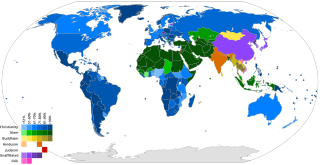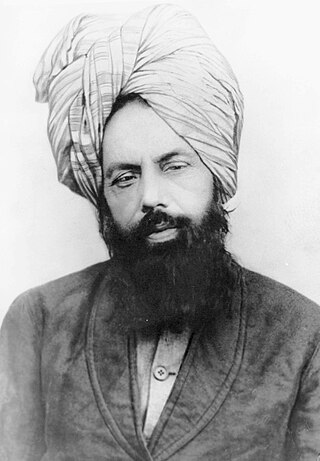Related Research Articles

A religious denomination is a subgroup within a religion that operates under a common name and tradition among other activities. The term refers to the various Christian denominations. It is also used to describe the five major branches of Judaism. Within Islam, it can refer to the branches or sects, as well as their various subdivisions such as sub-sects, schools of jurisprudence, schools of theology and religious movements.
Qadiani or Qadiyani is a religious slur used to refer to Ahmadi Muslims, primarily in Pakistan. The term originates from Qadian, a small town in northern India, the birthplace of Mirza Ghulam Ahmad, the founder of the Ahmadiyya movement. While it is pejorative to the Ahmadiyya Muslim Community, it is used in official Pakistani documents.

MirzāGhulām Ahmad was an Indian religious leader and the founder of the Ahmadiyya movement in Islam. He claimed to have been divinely appointed as the promised Messiah and Mahdi—which is the metaphorical second-coming of Jesus (mathīl-iʿIsā), in fulfillment of Islam's latter day prophecies, as well as the Mujaddid of the 14th Islamic century.

John Alexander Dowie was a Scottish-Australian minister known as an evangelist and faith healer. He began his career as a conventional minister in South Australia. After becoming an evangelist and faith healer, he immigrated with his family to the United States in 1888, first settling in San Francisco, where he expanded his faith healing into a mail order business. He moved to Chicago in time to take advantage of the crowds attracted to the 1893 World's Fair. After developing a huge faith healing business in Chicago, with multiple homes and businesses, including a publishing house, to keep his thousands of followers, he bought an expansive amount of land north of the city to set up a private community.

The Lahore Ahmadiyya Movement for the Propagation of Islam, is a separatist group within the Ahmadiyya movement that formed in 1914 as a result of ideological and administrative differences following the demise of Hakim Nur-ud-Din, the first Caliph after Mirza Ghulam Ahmad. Members of the Lahore Ahmadiyya movement are referred to by the majority group as ghayr mubāyi'īn and are also known colloquially as Lahori Ahmadis.

Al-Barāhīn al-Ahmadīyyah 'alā Haqīqatu KitābAllāh al-Qur'ān wa'n-Nabūwwatu al-Muhammadīyyah is a five-part book written by Mirza Ghulam Ahmad, the founder of the Ahmadiyya Movement. The first two parts were published in 1880 CE, the third volume was published in 1882, the fourth volume in 1884 and the fifth volume in 1905. In writing the book, Ghulam Ahmad sought to rejuvenate Islam by arguing for the validity of its principles and vindicating its teachings in response to Christian and Hindu polemics against Islam as well as atheistic philosophies. In this context, a significant portion of the subject matter of the book is dedicated to the defence of Islam as a whole against the criticism of Muhammad, the Qur'an and Islam that was raised in the 18th and 19th centuries predominantly by Christian missionaries and Hindu revivalists.

Al-Masih ad-Dajjal, otherwise referred to simply as the Dajjal, is an evil figure in Islamic eschatology similar to the Antichrist in Christianity, who will pretend to be the promised Messiah, appearing before the Day of Judgment according to the Islamic eschatological narrative. The Dajjal is not mentioned in the Quran, but he is mentioned and described in the ḥadīth literature. Like in Christianity, the Dajjal is said to emerge out in the east, although the specific location varies among the various sources. The Dajjal will imitate the miracles performed by ʿĪsā (Jesus), such as healing the sick and raising the dead, the latter done with the aid of devils (Shayāṭīn). He will deceive many people, such as weavers, magicians, half-castes, and children of fornication.
Ordinance XX is a legal ordinance of the Government of Pakistan that was promulgated under the regime of General Muhammad Zia-ul-Haq on 26 April 1984 and is meant to prohibit the practice of Islam and the usage of Islamic terms and titles for the Ahmadiyya Community. The ordinance bars Ahmadi, who are deemed Non-Muslims under the Pakistani constitution, from publicly practising the Islamic faith and also disallows them from using any Islamic texts for praying purposes. It is in addition to – but separate from – the 1974 Second Amendment to the Constitution of Pakistan. While the Second Amendment declared that Ahmadis are non-Muslims, the Ordinance prohibits Ahmadis from identifying themselves as Muslims.

The Fazl mosque also known as The London mosque, is the first purpose-built mosque in London, England. It was opened on 23 October 1926 in Southfields, Wandsworth. At a cost of £6,223, the construction of the place and the purchase of the land on which it stands, was funded by the donations of Ahmadi Muslims. Between 1984 and 2019 the Fazl Mosque was the residence of the caliphs of the Ahmadiyya Muslim Community, and therefore its de facto international headquarters. The administrative headquarters now lies at the site of the Islamabad, Tilford.

The Ahmadiyya branch of Islam has been subjected to various forms of religious persecution and discrimination since the movement's inception in 1889. The Ahmadiyya Muslim movement emerged within the Sunni tradition of Islam and its adherents believe in all of the five pillars and all of the articles of faith required of Muslims. Ahmadis are considered non-Muslims by many mainstream Muslims since they consider Mirza Ghulam Ahmad, the founder of the movement, to be the promised Mahdi and Messiah awaited by the Muslims.

The Minaret-ul-Masih is a stone tower and monument standing beside the Aqsa Mosque in Qadian, India. It was constructed under the direction of Mirza Ghulam Ahmad, the founder of the Ahmadiyya movement specifically as a lighthouse symbolising the ultimate pre-eminence of Islam.

Ahmadiyya, officially the Ahmadiyya Muslim Community or the Ahmadiyya Muslim Jama'at, is an Islamic revival or messianic movement originating in Punjab, British India, in the late 19th century. It was founded by Mirza Ghulam Ahmad (1835–1908), who claimed to have been divinely appointed as both the Promised Mahdi and Messiah expected by Muslims to appear towards the end times and bring about, by peaceful means, the final triumph of Islam; as well as to embody, in this capacity, the expected eschatological figure of other major religious traditions. Adherents of the Ahmadiyya—a term adopted expressly in reference to Muhammad's alternative name Aḥmad—are known as Ahmadi Muslims or simply Ahmadis.

The Furqan Force or Furqan Battalion was a uniformed Battalion force of volunteers of the minority Ahmadiyya Muslim Community in the Dominion of Pakistan. Formed in June 1948 at the direction of Head of the Worldwide Ahmadiyya Muslim Community, Mirza Basheer-ud-Din Mahmood Ahmad, at the request of Pakistan government, the unit fought for Pakistan against India in the First Kashmir War. In addition to its troops being drawn from the Ahmadiyya population, the expenses of maintaining the unit were also paid by that community.

Ahmadiyya is an Islamic branch in Indonesia. The earliest history of the community in Indonesia dates back to the early days of the Second Caliph, when during the summer of 1925, roughly two decades prior to the Indonesian revolution, a missionary of the Community, Rahmat Ali, stepped on Indonesia's largest island, Sumatra, and established the movement with 13 devotees in Tapaktuan, in the province of Aceh. The Community has an influential history in Indonesia's religious development, yet in the modern times it has faced increasing intolerance from religious establishments in the country and physical hostilities from radical Muslim groups. The Association of Religion Data Archives estimates around 400,000 Ahmadi Muslims, spread over 542 branches across the country.

Majlis Ansarullah is an auxiliary organization of the Ahmadiyya Muslim Community for men above forty years of age. It was founded in 1940 by Mirza Bashir-ud-Din Mahmud Ahmad, the second caliph of the Community. As an organization comprising the elders of the Community, it often provides intellectual and spiritual guidance for its younger members and has local and national leadership, with national leaders reporting directly to the caliph. Majlis Ansarullah are true Muslims who have accepted the rue coming of the promised messiah.
The word Mirzai is a religious slur used to refer to Ahmadis by many South Asian Muslims, primarily in Pakistan where they have been persecuted from early days and specially after the passage of Second Amendment to the Constitution of Pakistan which declares that Ahmadia are not Muslims and Ordinance XX. Ahmadis are the followers of Mirza Ghulam Ahmad of Qadian.
Kalsian is a small village located in Sheikhupura District, Punjab, Pakistan. It is located at 32°4'0N 73°52'0E and lies about 30 km North-West of Sheikhupura city. The name Kalsian is originated from kala shiin, which was taken from the early days of its settlement by its founders. When settlers from other parts of sub-continent came to this part to lay their footprints, they had a black panther in their neighbourhood jungle and afterwards they named the place kala shiin and then it kept on changing and lastly had Kalsian in the registries of Government books. Another theory regarding the origin of the name Kalsian is that at the time of settling the forefathers found here black mud which was in Punjabi pronounce as KALI Seehn that afterwards changed to kalsianThe nearest city from village Kalsian Bhatiian is Khangah Dograh(Urdu: خانقاہ ڈوگراں) on the soth, Ajniyyah wala on the north, and Farooq Abad on the east۔ It is situated between villages Aswah Bhattian, Takha Bhattian(Urdu: تکھہ بھٹیاں), Gajiana Nau and Baka Bhattian

Pandit Lekh Ram was a 19th-century social reformer, publicist, and writer from Punjab, India. He was the leader of the radical wing within the Arya Samaj, an Indian Hindu reform movement. He was known for his criticism of the caste system, superstitions, and blind faith prevalent in Hinduism. He also advocated for the education and empowerment of women. He is also known particularly for his encounters with Mirza Ghulam Ahmad, the founder of the Ahmadiyya movement, and as a subject of his death prophecy. Lekh Ram's outspoken views and writings made him a controversial figure, and he faced opposition and violence from conservative Hindus and Muslims. He was assassinated in 1897 by a group of religious extremists who were outraged by his criticism of their religion. His assassination by an unidentified assailant on March 6, 1897 is believed by Ahmadi Muslims to have occurred in accordance with Ahmad's prophecy concerning him.

Ahmadiyya is an Islamic religious movement originating in 1889 in northern India around the teachings of Mirza Ghulam Ahmad (1835–1908), who claimed to have been divinely appointed as both the promised Mahdi and Messiah expected by Muslims to appear towards the end times.

The Ahmadiyya branch in Islam has relationships with a number of other religions. Ahmadiyya consider themselves to be Muslim, but are not regarded as Muslim by mainstream Islam. Mainstream Muslim branches refer to the Ahmadiyya branch by the religious slur Qadiani, and to their beliefs as Qadianism a name based on Qadian, the small town in India's Punjab region where the founder of Ahmadiyya, Mirza Ghulam Ahmad was born.
References
- ↑ Simon Ross Valentine. Islam and the Ahmadiyya Jama'at: History, Belief, Practice . Columbia University Press, 2008. ISBN 0-231-70094-6, ISBN 978-0-231-70094-8